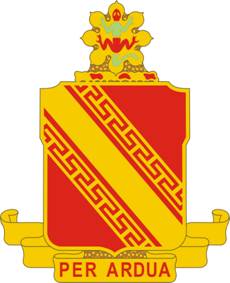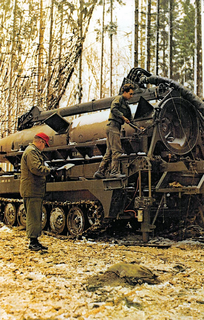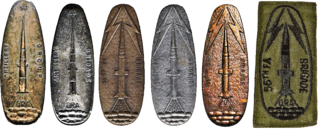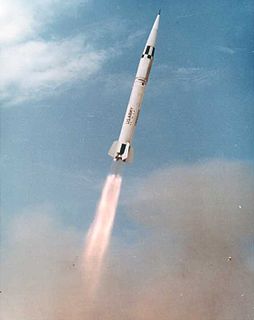
A regiment is a military unit. Their role and size varies markedly, depending on the country and the arm of service.

The PGM-11 Redstone was the first large American ballistic missile. A short-range ballistic missile (SRBM), it was in active service with the United States Army in West Germany from June 1958 to June 1964 as part of NATO's Cold War defense of Western Europe. It was the first US missile to carry a live nuclear warhead, in the 1958 Pacific Ocean weapons test, Hardtack Teak. Chief Engineer Wernher von Braun personally witnessed this historic launch and detonation.
The 119th Field Artillery Regiment is a United States Army Regimental System parent artillery regiment, represented in the Michigan Army National Guard by the 1st Battalion, 119th Field Artillery Regiment.

The Air Defense Artillery branch is the branch of the United States Army that specializes in anti-aircraft weapons. In the U.S. Army, these groups are composed of mainly air defense systems such as the Patriot Missile System, Terminal High Altitude Area Defense (THAAD), and the Avenger Air Defense system which fires the FIM-92 Stinger missile. The Air Defense Artillery branch descended from Anti-Aircraft Artillery into a separate branch on 20 June 1968. On 1 December 1968, the ADA branch was authorized to wear modified Artillery insignia, crossed field guns with missile. The Branch Motto, "First To Fire", was adopted in 1986 by the attendees of the ADA Commanders' Conference at Fort Bliss. The motto refers to a speech given by General Jonathan Wainwright to veterans of the 200th Coast Artillery (Antiaircraft) stating they were the 'First to Fire' in World War II against the Empire of Japan.

The MGM-52 Lance is a mobile field artillery tactical surface-to-surface missile system used to provide both nuclear and conventional fire support to the United States Army. The missile's warhead was developed at Lawrence Livermore National Laboratory. It was replaced by MGM-140 ATACMS, which was initially intended to likewise have a nuclear capability during the Cold War.
This Pershing missile bibliography is a list of works related to the Pershing 1 and Pershing 1a Field Artillery Missile Systems and the Pershing II Weapon System.

The 56th Field Artillery Command was a brigade size element of the United States Army. The unit was constituted in 1942 with the last period of active service being 1963 through 1991 with the nuclear Pershing missile system.

The 59th Ordnance Brigade is a military unit of the United States Army. The unit is currently stood up as the U.S. Army Ordnance School's training brigade. In its previous iteration, the brigade had more than 6,500 soldiers. It was responsible for storage, delivering, maintaining, Nuclear and Chemical Control Orders, and supervising the weapons of mass destruction for U.S. Forces and Forces of the Allied NATO-Countries, except France.
The 9th Field Artillery Regiment is a field artillery regiment of the United States Army first formed in 1916. The regiment served in Hawaii during World War I, 3rd, 4th, 7th, and 9th Divisions between the world wars, and with 3rd Infantry Division during World War II and Korea. Since 1957, the regiment has been a parent regiment under the Combat Arms Regimental System and the U.S. Army Regimental System, with regimental elements serving with the 3rd, 4th, 10th, 25th, 79th, 83rd, and 96th Infantry Divisions and various field artillery brigades and groups. The regiment's single active component, the 1st Battalion, 9th Field Artillery Regiment, is assigned to the 2nd Brigade Combat Team, 3rd Infantry Division and stationed at Fort Stewart, Georgia.

The 41st Field Artillery Regiment is a field artillery regiment of the United States Army.
The 79th Field Artillery Regiment is a field artillery regiment of the United States Army. First constituted 1916 in the Regular Army.

The 44th Air Defense Artillery Regiment is an Air Defense Artillery regiment of the United States Army, first constituted in 1918 in the Regular Army during World War I. During World War II the unit served as the 54th Coast Artillery Regiment (Colored), a segregated unit with mostly African American enlisted men and white officers, one of the few African American artillery units in that war. A preceding unit in World War I was the 54th Artillery.

The 81st Field Artillery Regiment is a field artillery regiment of the United States Army.

The 84th Field Artillery Regiment is a field artillery regiment of the United States Army.

From 1960 to 1988 there were Pershing missile launches for testing from various sites in the US. The systems included the Pershing 1 Field Artillery Missile System, the Pershing 1a Field Artillery Missile System and the Pershing II Weapon System. Initial launches were from what is now the Eastern Range at Cape Canaveral, Florida using Launch Complex 30A using the dismounted erector launcher. Later launches were from the full transporter erector launcher (TEL). Further launches were conducted at White Sands Missile Range (WSMR) using tactical equipment. The Pershing 1 and 1a had a range of 740 kilometres (460 mi), thus launches were from various subinstallations into WSMR. The two-stage Pershing II had a range of 1,770 kilometres (1,100 mi), thus launches at WSMR used a single-stage missile with two-stage launches at Cape Canaveral.

The Pershing II Weapon System) was a solid-fueled two-stage ballistic missile designed and built by Martin Marietta to replace the Pershing 1a Field Artillery Missile System as the United States Army's primary nuclear-capable theater-level weapon. The U.S. Army replaced the Pershing 1a with the Pershing II Weapon System in 1983, while the German Air Force retained Pershing 1a until all Pershings were eliminated in 1991. The U.S. Army Missile Command (MICOM) managed the development and improvements, while the Field Artillery Branch deployed the systems and developed tactical doctrine.

The 55th Support Battalion was a unit of the United States Army, which was last active from 9 July 1982 to 15 June 1991.

The Pershing Operational Test Unit (POTU) was the U.S. Army agency responsible for the operational testing of the Pershing 1 Field Artillery Missile System, the Pershing 1a Field Artillery Missile System and the Pershing II Weapon System. Created in 1965, POTU was assigned to United States Army Europe and located in Heidelberg, Germany. Personnel consisted of one lieutenant colonel, two majors, one captain, two warrant officers and four non-commissioned officers.
















